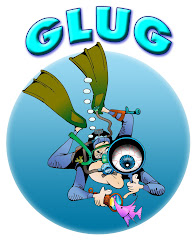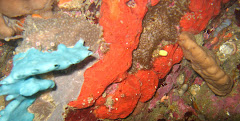Friday, May 25, 2012
Dive Trip to North Latitude and Bennett’s Bommie, 5th May, 2012
The dive started out with a bit of confusion despite the magnificent morning weather as both Suzanne and Peter turned up as extras to dive with Forster Dive Centre. Nick had indicated by phone that morning that there was room for two extras but once the boat was loaded he realized that other non-GLUG divers had brought friends unannounced to dive, some being in the extra extra large category. So although both Suzanne and Pete tried to pull out, the very gracious Rachel and Heather insisted that they would give their dive up and go out the next day with Nick.
So after an embarrassing start and a farewell from Rachel and Heather, the group headed out to Latitude. The dive buddy groups for the first dive were Suzanne, Tony and Anita; and Brian and Peter. Despite the sun fading before the first dive the visibility was not too bad, about 7- 9m. Due to a fairly strong current we decided to do a roaming debris survey and collection rather than use transect lines. The findings comprised a single aluminium can and an anchor was found by the non-GLUG group but was left in situ. The habitat comprised mostly of kelp-covered rock. In terms of fish species there were plenty of bait fish, red morwong, a leather jacket, a single striped catfish, lots of blue grouper, wobbegongs, crimson-banded and other wrasses and a tropical long nose butterfly. The highlight species were several - a small green turtle and a beautiful large spotted eagle ray with a tail length of at least 2 metres. The maximum depth of the dive was 19-21m and dive time was around 50 minutes.
The surface interval was not very pleasant. The sun was gone and the wind had sprung up and there were some seriously noisy chundering companions from the non-GLUG contingent. They were very sick and not very happy, but spent most of their time bouncing around in the water while the non-sickies tried to ignore their noises and chunder and pretend to enjoy the lovely soup, bikkies and lollies provided by Nick. There was much discussion as to whether the second dive could go ahead or whether we should offload the off-colour divers first, but we ended up at Bennett’s Head bommy and all went below.
Dive pairs consisted of Janne and Tony, Brian and Peter; and Suzanne and Anita. The habitat was again kelp-covered rock on a sand floor base. The visibility was poor (2-5m max) and the current was strong. Again we did a roaming debris collection and I found a broken crab trap. Again there were plenty of baitfish around and lots of ornate wobbegongs, a few Port Jackson sharks and fiddler rays. I found a beautiful gastropod buried in the shell and soon found out how razor-sharp is the edge of the shell-opening. Max. depth was around 11m and dive time around 50 minutes, but the decreasing visibility and increasing current made heading for the top a more desirable option.
Back on board dear Nick experienced boat problems as the steering broke and he did a very professional job steering us through the bar using his reverse gear when necessary. Back at the Dive Centre the gear washing and hot shower services were most appreciated and our dear Heather and Rachel had returned to greet us and show the fruits of their labour. They had snorkeled in Breckenridge Channel and collected more debris than us! Well done girls – they also stayed on for the scrumptious GLUG BBQ organized by Anita and Janne.
Friday, May 18, 2012
Big Seal Rock, 12 May 2012
BIG SEAL ROCK -SATURDAY 12TH MAY 2012
DIVE 1 - SOUTH EAST CORNER -Five members of the Great Lakes Underwater Group joined Action Divers to complete marine debris surveys, monitor grey nurse sharks and record fish life at Seal Rocks. A chilly wind was from the southwest meant we could not anchor too close so a shot line was put over the stern directly into the gutter.
Anita and I were first in the water and we were met by approximately forty males grey nurse sharks, many juveniles, and twenty females. Quite a few carried scars and one female had tackle trailing from her mouth – the hook way down in her stomach. She was in poor condition. Two others had thick monofilament line (long-line) with large stainless steel hooks and another had the top of its tail chopped off. Fortunately John managed to remove a hook from one individual, but it is frustrating to not be able to help the others.
A random marine debris survey was conducted as at a depth of 20 metres it was too deep to carry out transects, and one large stainless fishing hook with a trace was found and removed.
A fish identification survey recorded blue grouper, red morwong, comb wrasse, maori wrasse, crimson banded wrasse, girdled parma, common and small scale bullseyes, old wives, Moorish idols, half banded sea perch, sweep, mado, wobbegongs, bream, snapper, red rock cods, pufferfish, white cheeked scalyfin, kingfish, one spot pullers, black reef leatherjacket, moray eels and a free swimming older large loggerhead turtle.
The conditions were pleasant with a water temperature of 22 degrees and visibility of 15 metres.
DIVE 2 - WESTERN GUTTER – This dive was to 14 metres which meant Jordon and Brian were able to conduct marine debris transects. They did not find any debris however Anita found another large stainless steel hook with monofilament line buried in the sand on the north east gutter which she took back to the boat with her.
Approximately twenty grey nurse sharks were sighted with one female trailing a long section of fishing line covered in growth. Also recorded were surgeon fish, blue grouper, red morwong, kelp fish, comb wrasse, maori wrasse, crimson banded wrasse, girdled parma, common and small scale bullseyes, old wives, half banded sea perch, sweep, pike, yellowtail scad, wobbygongs, Port Jackson shark, bream, mado, stripeys, pufferfish, blackspot goatfish, luderick, blue damsels, one spot pullers, crested morwong, red morwong, bream, snapper, moray eels, six spine leatherjacket (male and female), Moorish idols, Lord Howe Island butterfly fish, black spot goatfish, blue and yellow fusilier, eastern hulafish and red rock cod.
The water temperature was 22 degrees with visibility at 8 metres however we began to feel the cold and headed back up the anchor to decompress whilst watching a large school of sweep swim about under the boat in the sunlight.
HEATHER ARMOUR.
Subscribe to:
Posts (Atom)


